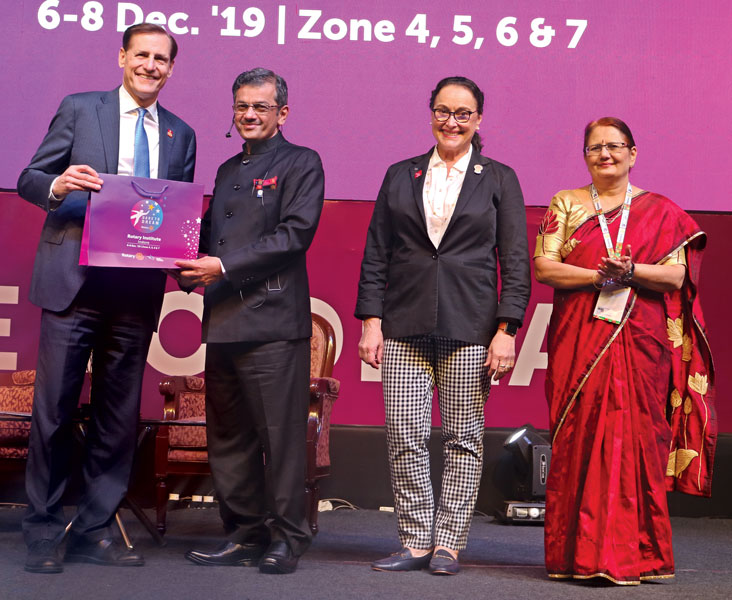
Where will Rotary be in the next 10 years? Will it still hold relevance to diverse professionals to do service projects? How is it going to handle the demographic challenge of binding people from two extreme stages of life? “This is really a great, hard circle to square, that is, having 75-year-old, retired people as members along with young 35-year-old professionals in the same club, feeling comfortable with each other and working in the same way,” said RI General Secretary John Hewko, addressing a Q&A session with RID Bharat Pandya at the Indore Institute.
Historically, Rotary has been a one-product shop as it offered a one-size-fits-all model, he said. “But we can’t afford the luxury of being a one-product shop any more. Our alternative products — young, classic, traditional or club model — should appeal to diverse demographics.” One of the strategic plans is to develop alternative paths for joining Rotary and it is a challenge to make it happen.
Rotary is in such a situation now as it grapples with a stagnant membership of 1.2 million and the need to infuse young professionals.
In the last 114 years, Rotary has done some amazing projects. An organisation of over 100 years has “this trajectory of booming, growing, thriving and reaching a certain plateau in its natural course of history and then a gradual decline before reaching a point of no return, if it does not take measures to stem the rot and deal with this downward curve,” he said, citing the case of Kodak losing relevance after its grand presence as it did not deal with the steady decline in the growth curve. Rotary is in such a situation now as it grapples with a stagnant membership of 1.2 million and the need to infuse young professionals. Hewko believes Rotary can buck this trend, by taking “concrete action” on the new Strategic Plan which will be rolled out by the RI Board shortly.
Six challenges
While keeping it relevant over the next few decades will be a challenge, “there should be a continuous process of improvement and adapting to changes.” Are we going to be ‘nimble enough’ to adapt to changes, especially in technology, and deal with challenges we and other NGOs are facing?
Rotary has institutionalised discontinuity for very good reasons, he said. “We as an organisation are resigned to be discontinuous by design. Our president, RI Board, DGs and club presidents change every year. We need to have 10 years of continuous, consistent efforts to deal with challenges.” But there will be a time when we need continuity and that will be a problem. “We have to stay the course and avoid the zig-zagging that results in the encroachment of our governance structures.”
We have to respect the differences at the regional levels and at the same time, maintain the glue that binds us all in Rotary.
“We have to work on alternative models with bottom-up approach that are easily scalable, and replace polio as the next big thing for Rotary,” said Hewko. The next challenge is regionalisation. There are now increasing differences within Rotary around the world. “We have to respect the differences at the regional levels and at the same time, maintain the glue that binds us all in Rotary,” he said.
The organisational values and things that bring us together such as youth exchange, fellowship, global grants, and all the work we do have to be kept in mind. Finally, “we have elevated Rotaract as part of Rotary. How are we going to operationalise this? We have to be careful as we roll out this plan of action with Rotaractors becoming part of us.”
In a nutshell, relevance, adapting to changes, continuity, next global project, regionalisation and the new concept of Rotaract will be the challenge areas for Rotary in the years ahead.
1.4 million Rotarians
Confident of taking the membership to 1.4 million Rotaractors and 1.4 million Rotarians in the next 10 years, Hewko said young, sharp minds should be given an opportunity to “roll up their sleeves and get the job done in Rotary.”
The amount of money raised by Rotarians across the world through TRF giving, membership, grants and other donations is valued at $1.25 billion a year. “Now, if you add value of our volunteer time, $850 million (calculated by Johns Hopkins University) and the money we raised, we become a $2 billion-a-year NGO, one of the largest such organisations in the world right up there with Gates Foundation,” pointed out Hewko.
He reminded the Rotarians that by 2025 Rotary has to grow into a $2.025 billion NGO. “You are leading the way in India with your support. This goal is the most underlying financial foundation of Rotary going forward,” he said.
Picture by V Muthukumaran





